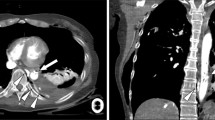Summary
The case of an 51-year-old man, who died about 24 hrs after having tried to commit suicide by hanging is reported. Death was caused by rupture of an arteriosclerotic layer in the left carotis communis artery with consecutive intramural bleeding and thrombosis of the left carotis communis, carotis interna and carotis externa arteries. In this respect another case of an injury of the neck and thrombosis of the carotis interna artery is reported.
On the basis of these two cases the clinical and legal importance of diagnosis and causal connexion are discussed.
Zusammenfassung
Es wird über einen Fall von Carotisthrombose nach Erhängungsversuch berichtet. Die Strangulation wurde um rund 24 Stunden überlebt. Ursächlich war ein dicht unter der Teilungsstelle der Carotis communis breit aufgebrochenes arteriosklerotisches Beet. Im Anschluß wird ein Nachbegutachtungs-fall geschildert, bei dem es nach Schleudertrauma der HWS zur Thrombose der Carotis interna gekommen war. Anhand beider Fälle wird darauf hingewiesen, daß Diagnose und kausale Zusammenhänge klinisch und rechtlich von großer Relevanz sind.
Similar content being viewed by others
Literatur
Brenner, H., Gerstenbrand, F., Spängler, H.: Beitrag zum Problem der traumatischen Carotisthrombose beim geschlossenen Schädeltrauma. Mschr. Unfallk. 65, 136–142 (1962)
Decker, K.: Klinische Neuroradiologie. Suttgart: Thieme 1960
Gerchow, J.: Zur Frage der Handlungsfähigkeit bei mechanischer Erstickung. Z. Rechtsmed. 77, 135–139 (1976)
Gerlach, H.: Spättod nach Strangulation. Dtsch. Z. ges. gerichtl. Med. 58, 50–54 (1966)
Harbitz, F.: Können Aneurysmen der Schädelgrundfläche (evtl. mit tödlicher Verblutung) durch Trauma entstehen? Dtsch. Z. ges. gerichtl. Med. 19, 463 (1932)
Hellmann, K.: Über stumpfe Verletzungen des Kehlkopfes durch Strangulation. Z. Hals-Nasen-Ohrenhk. 13, 115 (1925)
Holczabek, W.: Erstaunliche Aktionsfähigkeit nach Erhängungsversuch mit Reißen des Strickes. Arch. Kriminol. 134, 6–11 (1964)
Holzer, Fr. J.: Hufschlag oder Mord. Zugleich ein Beitrag zur Entstehung von Thrombosen bei Strangulation. Beitr. gerichtl. Med. 19, 48–52 (1952)
Isfort, A.: Traumatische Carotisthrombosen. Mschr. Unfallhk. 65, 257–267 (1962)
Jakob, H.: Strangulation. In: Handbuch der speziellen pathologischen Anatomie und Histologie. Bd. XIII, Teil 1, B, S. 1712–1731. Berlin-Göttingen-Heidelberg: Springer 1957
Jakob, H., Pyrkosch: Frühe Hirnschäden bei Strangtod und in der Agonie. Arch. Psychiatr. 187, 177 (1951)
Jungmichel, G.: Aneurysma einer basalen Hirnarterie nach Trauma. Dtsch. Z. ges. gerichtl. Med. 19, 197 (1932)
Kahlau, G.: Über die traumatische Entstehung von Aneurysmen der Hirnbasisarterien. Frankf. Z. Pathol. 51, 319 (1938)
Kazmeier, F.: Differentialdiagnose traumatischer und iatrogener schäden. I. Die traumatischen Hirn- und Rückenmarksschäden. In: Differentialdiagnose neurologischer Krankheitsbilder. G. Bodechtel (Hrg.), S. 787–807, 2. Auflage Stuttgart: Thieme 1963
Krauland, W.: Über Verletzungen der Schlagadern im Schädel durch stumpfe Gewalt und ihre Folgen. Beitr. gerichtl. Med. 18, 24 (1949)
Krauland, W.: Zur Entstehung traumatischer Aneurysmen der Schlagadern am Hirngrund. Schweiz. Z. Pathol. Bakter. 12, 113 (1949)
Krauland, W.: Verletzungen der Arteria carotis interna im Sinus cavernosus und Verletzungen der großen Hirnschlagadern mit Berücksichtigung der Aneurysmabildung. In: Handbuch der speziellen pathologischen Anatomie und Histologie. Bd. XIII, 3. Teil: Erkrankungen des zentralen Nervensystems III, W. Scholz (Hrg.) Berlin-Göttingen-Heidelberg: Springer 1955
Lesser, A.: Über die lokalen Befunde beim Selbstmord durch Erhängen. Vierteljahrschr. gerichtl. Med. 35, 237 (1881)
Murphy, F., J. H. Miller: Zit. bei Brenner et al. J. Neurosurg. 16, 1 (1959)
Pehans, H.: Über Carotisrupturen beim Tod durch Erhängen. Vierteljahrschr. gerichtl. Med. 8, Suppl. 176 (1894)
Reuter, F.: Über die anatomischen Befunde beim Tode durch Erdrosseln und durch Erhängen. Z. Heilk. Bd. XXII, 1901
Schmidt, W.: Ein Beitrag zur Statistik des Erhängungstodes. S. 19 ff. Inaug. Diss. Berlin 1901
Strauss, H.: Strangulationsfolgen und Hirnstamm. Z. Neur. 131, 363 (1931)
Walcher, K.: Über die extracerebralen Aneurysmen der Hirnarterien und deren traumatische Entstehung. Mschr. Unfallheilk. 40, 433 (1933)
Weinberger, L. M., Gibbon, M. H., Gibbon, J. H. jr.: Temporary arrest of the circulation to the central nervous system. Arch. Neurol. 43, 961–986 (1940)
Ziemke, E.: Über die Entstehung der Carotisintima-Rupturen und ihre diagnostische Bedeutung für den Tod durch Strangulation. Vierteljahrschr. gerichtl. Med. 37, 96–118 (1909)
Author information
Authors and Affiliations
Rights and permissions
About this article
Cite this article
Gerchow, J., Heberle, B. Traumatische Carotisthrombose. Z Rechtsmed 81, 243–248 (1978). https://doi.org/10.1007/BF00201274
Received:
Issue Date:
DOI: https://doi.org/10.1007/BF00201274
Key words
- Strangulation, thrombosis of the carotis communis artery
- Injury of the neck, thrombosis of the carotis interna artery




